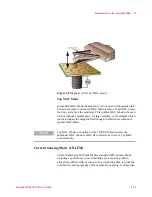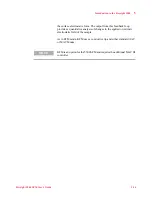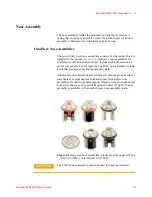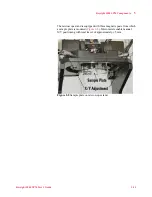
Introduction to the Keysight 5500
5
Keysight 5500 SPM User’s Guide
5-14
Lateral Force Microscopy (LFM)
Lateral Force Microscopy (LFM) is a derivative of Contact AFM with
the scan direction perpendicular to the long axis of the cantilever. In
LFM, the tip is constantly in contact with the sample surface. In addition
to its vertical deflection, the cantilever also twists in the scan direction.
As a result, along with the near-vertical deflection signal which is
usually present during Contact Mode AFM, the detector can also collect
a sizeable lateral defection (Friction) signal from the cantilever‘s
twisting motion. The strength of the lateral deflection signal is related to
the friction force between the sample surface and the tip; thus, LFM is
sometimes called Friction Force Microscopy.
The LFM signal is highly affected by topographic variations: the
rougher the sample surface, the more the topography will affect the
friction signal. To differentiate between friction and topography, two
images are typically captured side-by-side. One is constructed from the
detector signal during the trace (left-to-right tip motion) of each line in
the raster scan, and the other is mapped during retrace (right-to-left tip
motion). Then one of the two images is inverted and subtracted from the
other. This reduces the topographic artifacts in the LFM signal, leaving
an image of primarily frictional forces.
Dynamic Lateral Force Microscopy (DLFM)
In Dynamic Lateral Force Microscopy (DLFM), the tip is in contact
with the sample, and the cantilever is oscillated parallel to the sample
surface (as opposed to perpendicular oscillation in AC Mode). The
topography is determined by cantilever deflection, as in contact mode.
However, the lateral oscillation is also monitored, such that the
amplitude and phase can be imaged, as in standard AAC Mode. DLFM
is used in polymer studies as it is very sensitive to changes in surface
properties such as friction and adhesion.
NOTE
FMM requires MAC Mode or MAC III.
NOTE
DLFM requires MAC Mode or MAC III.
Содержание 5500
Страница 1: ...Keysight 5500 Scanning Probe Microscope User s Guide ...
Страница 2: ......
Страница 9: ...Read This First N9410 90001 Keysight 5500 SPM User s Guide ix Declaration of Conformity ...
Страница 174: ...Additional Imaging Modes 5 Keysight 5500 SPM User s Guide 5 40 Figure 7 23 Plug in Images window ...
Страница 215: ...Closed Loop Scanners 5 Keysight 5500 SPM User s Guide 5 17 Save the calibration file X Y Z calibration is now complete ...
Страница 274: ...Temperature Control 5 Keysight 5500 SPM User s Guide 5 8 Figure 13 10 7500 9500 hot sample plate wiring diagram ...
Страница 275: ...Temperature Control 5 Keysight 5500 SPM User s Guide 5 9 Figure 13 11 5500 hot MAC sample plate wiring diagram ...
Страница 276: ...Temperature Control 5 Keysight 5500 SPM User s Guide 5 10 Figure 13 12 7500 9500 hot MAC sample plate wiring diagram ...
Страница 284: ...Temperature Control 5 Keysight 5500 SPM User s Guide 5 18 Figure 13 21 5500 Peltier Cold sample plate wiring diagram ...
Страница 297: ...Thermal K 5 Keysight 5500 SPM User s Guide 5 9 Figure 14 8 Select units after calibrating the Force Constant ...
Страница 330: ...Keysight Technologies 5500 SPM User s Guide Part Number N9410 90001 Revision H Keysight Technologies 2015 ...






























